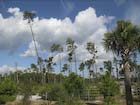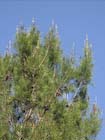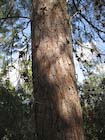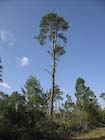Pinus clausa
(Chapm. ex Engelm.) Vasey ex Sarg. 1884
Common names
Sand pine, spruce pine, scrub pine (Brendemuehl 1990).
Taxonomic notes
Syn: Pinus inops Aiton var. clausa Chapman ex Engelmann 1877; P.clausa var. immuginata D.B. Ward (Kral 1993). Some authorities discriminate the eastern and southern, serotinous trees as the Ocala race, P. clausa var. clausa, and the range-disjunct northwestern, non-serotinous trees as the Choctawhatchee race, P. clausa var. immuginata D.B. Ward 1963.
Description
"Trees to 21 m; trunk to 0.5 m diam., straight and erect to leaning and crooked, much branched; crown mostly rounded or irregular. Bark gray to gray-brown, furrowed, with narrow, flat, irregular ridges, resin pockets absent, on upper sections of the trunk reddish to red-brown, platy becoming smooth distally. Branches spreading to ascending, poorly self-pruning; twigs slender, violet- to red-brown, rarely glaucous, aging gray, smooth. Buds cylindric, purple-brown, to 1cm; scale margins white-fringed. Leaves 2 per fascicle, spreading-ascending, persisting 2-3 years, (3-)6-9(-10) cm x ca. 1 mm, straight, slightly twisted, dark green, all surfaces with fine, inconspicuous stomatal lines, margins finely serrulate, apex short-conic; sheath 0.3-0.5(-0.7) cm, base persistent. Pollen cones ellipsoid, ca. 10 mm, brownish yellow. Seed cones maturing in 2 years, shedding seeds soon thereafter or often long-serotinous, 4 long-persistent, solitary or whorled, spreading, symmetric (rarely slightly asymmetric, reflexed), lanceoloid before opening, ovoid to broadly ovoid when open, 3-8 cm, red-brown, sessile or on stalks to 1 cm, scales with dark red-brown, purple, or purple-gray border distally on adaxial surface; apophyses thickened, shallowly and angulately raised, transversely rhombic, cross-keeled; umbo central, low-pyramidal, tapering to sharp tip or weak, often deciduous prickle. Seeds obovoid-oblique; body ca. 4 mm, dark brown to nearly black; wing to 17 mm. 2n=24" (Kral 1993). The species resembles both P. banksiana and P. virginiana, and like the former includes both serotinous and non-serotinous races (Will Blozan e-mail 2009.01.04). Prior to 1884, in fact, both this species and P. virginiana were commonly united under the name Pinus inops Bong. (Lambert 1803).
Distribution and Ecology
USA: Alabama and Florida, at 0-60 m elevation (Kral 1993). The largest sand pine concentration is a block of the variety clausa covering about 101,170 ha in N-C FL, an area often referred to as the "Big Scrub." This variety of sand pine also grows in a narrow strip along the E coast of FL from St. Augustine southward to Fort Lauderdale, and along the Gulf Coast in small tracts scattered from a few km N of Tampa, S to Naples. Variety immuginata grows along the coast in W FL from Apalachicola to Pensacola and W into Baldwin County, AL. This variety is most abundant in Okaloosa and Walton Counties, FL, covering an area of about 40,470 ha. Scattered stands of this variety can be found 32 to 40 km inland from the coast in this section of FL. Sparse stands of sand pine are also found on many of Florida's offshore islands (Brendemuehl 1990). Hardy to Zone 9 (cold hardiness limit between -6.6°C and -1.1°C) (Bannister and Neuner 2001). See also Thompson et al. (1999).
Distribution data from USGS (1999).
The species grows in pure stands on acid to strongly acid sand soils (Entisols) of marine origin. Var. clausa in N-C FL experiences hot, humid summers and mild, dry winters. Precipitation averages 1350 mm per year, and varies from 50 to 75 mm per month from October to April, with as much as 200 to 230 mm per month in June, July, and August. The recorded temperature has ranged from -11°C to 41°C, with a mean frost-free period of 290 days. Var. immuginata experiences a slightly wetter, cooler climate. Precipitation averages 1520 mm per year, and varies from 100 to 110 mm per month from December to May. The recorded temperature has ranged from -17°C to 42°C, with a mean frost-free period of 265 days (Brendemuehl 1990).
In N-C FL P. clausa var. clausa forms a highly distinctive community amongst areas of predominantly sandhill community dominated by longleaf pine (Pinus palustris), turkey oak (Quercus laevis), and pineland threeawn (Aristida stricta). In these areas, even-aged P. clausa dominates the overstory, while the understory is composed almost entirely of evergreen shrubs 1.8 to 3.0 m tall. There is little or no herbaceous ground cover. Shrubs found in this understory include sand live oak (Quercus virginiana var. geminata), myrtle oak (Q. myrtifolia), Chapman oak (Q. chapmanii), rosemary (Ceratiola ericoides), tree lyonia (Lyonia ferruginea), scrub palmetto (Sabal etonia), saw-palmetto (Serenoa repens), silk bay (Persea borbonia var. humilis), gopher-apple (Chrysobalanus oblongifolius), and ground blueberry (Vaccinium myrsinites). Mats of lichens (Cladonia spp.) are often plentiful on the ground beneath the trees and shrubs. In contrast, the P. clausa var. immuginata community of W FL grows in uneven-aged stands and invades adjacent forested sites if protected from uncontrolled fire. The understory in these stands is quite sparse. Turkey oak, bluejack oak (Q. incana), sand post oak (Q. stellata var. margaretta), pineland threeawn, and prickly pear (Opuntia spp.) are the most common species of this understory (Brendemuehl 1990).
The species is often found on sites that are subject to hurricanes. The trees in these groves often lean in one direction (photo at right) (Will Blozan e-mail 2009.01.04).
The principal disturbance agents affecting P. clausa include fire, insects, and pathogens. The tree is much less fire resistant than other pines in its range such as P. palustris and P. elliottii. Hot ground fires will kill it as readily as crown fires, and factors such as long branch retention and a dense understory contribute to a high incidence of crown fires. A unique combination of fuel and weather conditions is associated with crown fires that occur in forests of var. clausa. The moisture content of sand pine needles is often lowest in March, and their resin and energy contents reach a yearly high from February through May. These fuel properties take on critical importance when they are combined with severe drought conditions and blustery spring weather characterized by unstable air masses, low relative humidity, and high winds. The conditions may result in spectacular crown fires that release seed from the serotinous cones, helping to perpetuate the species in an edaphic fire climax (Brendemuehl 1990). Myers (1990) reports that wildfire in sand pine stands usually exhibits extreme and uncontrollable behavior, relating a fire in Ocala National Forest in 1935 that burned 2,295 ha in 4 hours. However, controlled burning is possible and provides the principle hope for protecting remnant native stands from conversion to oak, which otherwise is the consequence of fire suppression (FEIS).
The principal insect pests also attack the other species of pine growing in Florida, and are found throughout the range of P. clausa. They include bark beetles and sawflies, but a variety of lesser insects pests have also been recorded. Bark beetles, primarily Ips calligraphus and I. grandicollis, cause the greatest volume loss in sand pine, especially among var. immuginata. These attacks are generally associated with stress factors such as severe drought, lightning, fire, mechanical damage, or crowded stand conditions. The sand pine sawfly (Neodiprion pratti) reduces the productivity of affected trees, and afflicts both varieties of P. clausa. Attacks are reported to be most severe along stand edges and in plantations with fewer than 750 trees per hectare (Brendemuehl 1990).
Sand pine varies in its susceptibility to pathogens. Mushroom root rot caused by Clitocybe tabescens is found in natural stands of var. clausa, but var. immuginata is considered resistant to this disease. Phytophthora cinnamomi is reported to be a virulent pathogen on seedlings of both varieties, but there is no conclusive proof that this fungus is a pathogen of P. clausa under field conditions. Eastern gall rust (Cronartium quercuum), which forms spherical galls mainly on twigs and branches of both P. clausa varieties, is common but seldom a serious problem. Heart rot caused by Phellinus pini has been reported in sand pine but is usually not a problem until the stands are more than 40 years old, a relatively advanced age in this species (Brendemuehl 1990).
The seeds are known to be eaten by the wild turkey (Meleagris gallopavo), bobwhite quail (Colinus virginianus), fox squirrel (Sciurus niger), gray squirrel (Sciurus carolinensis), and mourning dove (Zenaidura macroura) (NCSU Dendrology Project n.d.).
Remarkable Specimens
The largest tree on record is of var. clausa, 65 cm dbh and 26.12 m tall with a crown diameter of 8.5 m; height measured by laser; located near Saint Cloud, Florida (Will Blozan e-mail 2009.01.04). I have no data for var. immuginata. Two former large trees included dbh 70 cm, height 29 m, crown spread 12 m; also dbh 62 cm, height 30 m, crown spread 13 m; both located in Starkey Wilderness Park, Florida (American Forests 1996). These two trees are no longer listed, and have presumably died or been reduced in stature, probably by a hurricane.
The oldest tree is... not very. This is among the most short-lived pines. Brendemuehl (1990) refers to no trees older than 60 years, and the alludes briefly to trees of 100 years. I have found no accounts of older trees.
Ethnobotany
In peninsular Florida P. clausa is managed to produce a high volume of pulpwood. It has low timber value due to numerous persistent dead limbs and often crooked trunks (Kral 1993, Will Blozan e-mail 2009.01.04).
Observations
Lake Lizzie Nature Preserve near Saint Cloud, FL sounds like a good place to see it. This is near the location of the largest known specimen (Will Blozan e-mail 2009.01.03).
Remarks
The epithet clausa means "closed", referring to the seed cones.
Citations
American Forests 1996. The 1996-1997 National Register of Big Trees. Washington, DC: American Forests.
Brendemuehl, R. H. 1990. Sand pine, in Burns and Honkala (1990).
FEIS database.
Lambert, Aylmer Bourke. 1803. A Description of the Genus Pinus. London: J. White.
Myers, Ronald L. 1990. Scrub and high pine. Pp. 150-193 in R.L. Myers and J.J. Ewel (eds.), Ecosystems of Florida. Orlando, FL: University of Central Florida Press.
NCSU Dendrology Project. [n.d.]. Pinus clausa (Chapm. ex Engelm.) Vasey ex Sarg. https://projects.ncsu.edu/project/dendrology/index/plantae/vascular/seedplants/gymnosperms/conifers/pine/pinus/contortae/sand/sandpine.html, accessed 2019.02.28.
Sargent, C. S. 1884. Report on the Forests of North America (Exclusive of Mexico). Washington: Government Printing Office. p. 199. Available https://www2.census.gov/prod2/decennial/documents/1880a_v9-03.pdf, accessed 2019.02.28.
Ward, Daniel B. 1963. Contributions to the flora of Florida-2, Pinus (Pinaceae). Castanea 28:1-10.
See also





